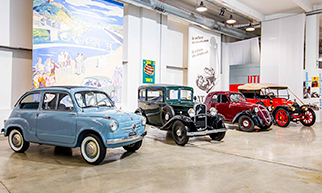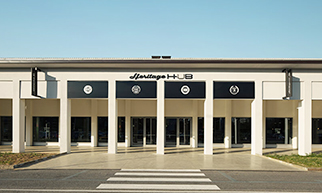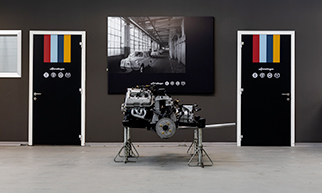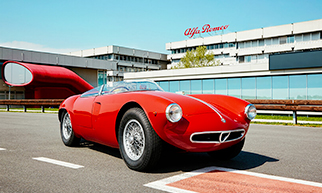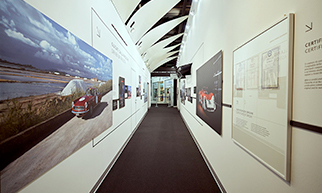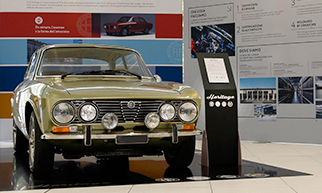Lancia designed its trump card to counter fierce competition in the racing world. In 1985, a very powerful car was created, with the ability to blend the merits of its forerunner the “037” with emerging – now irreplaceable – technologies: from all-wheel drive to turbo.
Early work on the Lancia Delta S4 began in January 1983, just as its forerunner the Lancia Rally “037” continued to dominate the podium at the Monte Carlo Rally – with Röhrl/Geistdörfer first and Alén/Kivimäki second. The opening race that season would go on to cement victory in the Constructors' World Championship with Lancia’s final rear-wheel drive model.
Sports Director Cesare Fiorio and the entire Lancia team were aware of how much the future of rallies revolved around two fulcrums: the incessant growth of engine power and the ability to unload it to the ground. The Lancia Rally Group B of the time, the result of the evolution of the Beta Montecarlo, was inferior to the competition in both aspects: the supercharging with volumetric compressor, despite its advantages, offered less power escalation than the turbo; the all-wheel drive used by the German and French teams was evidently much more effective than rear-wheel drive alone, especially in conditions of poor grip.
It became necessary to design a totally new car that could use both turbo and all-wheel drive: hence the choice of the name S4, where S stood for ‘supercharged’ and 4 for ‘four-wheel drive’. However, we justifiably did not wish to give up the elements that continued to make the “037” competitive: the architecture that allowed maximum speed in assistance in the race; the engine torque at low revs offered by the volumetric compressor, more so than the turbo. For marketing reasons, the car had to recall the silhouette of the standard Delta, from which – on a practical level – only the name was taken: hence the Lancia Delta S4, known at Abarth, long since the Group's sports division, as the SE 038 project.
The new design began with the engine: the first stroke of genius of the engineer Lombardi, former technical director of engines at Lancia from 1975, was to combine the two supercharging systems yet maintain the high volumetric that remained active at low revs, to be disconnected with a bypass system around 3,000 rpm, when the pressure generated by the turbo began to be effective.
The four-cylinder was no longer based on production units as had been the previous Lancia Stratos HF (Ferrari Dino), nor on the Beta family in the case of the Rally 037, but was produced as a racing unit: the technical inventions adopted included dry sump, ignition and electronic injection, crankcase and cylinder head in light alloys and liners hardened with ceramic treatments. Lombardi himself would define it as “technologically sophisticated like a Formula 1 engine”.
The new four-wheel transmission involved the use of three differentials: the front and rear ones were mechanical self-locking with different calibrations, whereas the central one had a sophisticated Ferguson-type viscous system, with distribution between the two axles that could vary between 65% at the rear and 35% at the front, up to an ratio of 80:20. The five-speed gearbox with front clutches and straight teeth had the typical ZF scheme, with the first gear at the bottom, the reverse gear forward with release “syringe” and the other four as H-gears.
The architecture of the body revolved around the solution already in use on the Lancia Rally, in any case affected by an evolution of materials. The engine remained central/rear in a longitudinal position inclined by 20° and anchored to a central cell formed by box panels reinforced by the safety rollbar, with two tubular subframes to support the geometry of the front and rear suspension. The water and oil radiators were housed in the front compartment, whereas the fuel tank was divided into two parts located in the middle, under the seats, giving that characteristic raised driving position.
Finally, the bodywork consisted of lightweight elements, bonnets and doors in Kevlar and carbon fibre, which could easily be removed for both maintenance and replacement. Another of its characteristic features was two rear pillars with large intakes to bring air into the engine compartment, known affectionately as “ears”.
A minimum of 200 units of the Lancia Delta S4 needed to be produced to obtain type approval in Group B, received on 1 November 1985. Barely a month later, the first double at the RAC to end the season, ahead of the victory at the Monte Carlo Rally that opened the fateful, mocking 1986 season.
For the car to be type-approved in Group B, at least 200 units needed to be produced. Then, at the same time as early testing, production of the "Stradale" version started, to a large extent compliant with the architecture of the "racing" versions. To save time, these were also assembled in the Abarth atelier on Corso Marche, Turin. The engine retained the double volumetric + turbo supercharging with IAW (Weber Ignition Injection) electronics for smoother delivery and to contain power to about 250 hp, compared to the 430, 480 and 510 of the different racing configurations, conversely switched to more sophisticated Bosch systems.
The well-kept and much more comfortable interior sported two elegant, sporty and ergonomic seats upholstered in Alcantara, as part of the dashboard and central tunnel. The engine compartment, behind the seats, was closed by a top covered with the same beige carpet as the floors. The intake heat exchangers had been resized, with the bodywork retaining the two characteristic large-opening Kevlar and carbon-fibre shells that included the fenders and improved accessibility to all the mechanical parts, front and rear. Three official colours: mica metallic red (updated to the contemporary era yet reminiscent of the Montebello Amaranth of the first Fulvia Coupé HF in the 1960s), metallic black and metallic grey. The sale price was also exceptional: 110,782,000 Italian lire, more than its peer the Ferrari 328 GTB, listed at about 94 million lire.
Testing of the racing version had been taking place steadily from autumn 1984 at the Mandria Park circuit, a private facility near Venaria Reale on the outskirts of Turin. Giorgio Pianta, a manager but a test driver himself, roughed up the SE 038 with the fundamental contribution of other official Lancia drivers, one of the most assiduous being the young Miki Biasion.
It was type-approved for Group B on 1 November 1985; after a few appearances as an opener out of the standings, which immediately caused a sensation among the press and insiders for the performance on display, the car could finally be entered in competitions. The official debut in the world championship took place at the last race of the season: the deadly Lombard RAC Rally. There were immediately two Delta S4s on the top steps of the podium: first Toivonen/Nail and second Alén/Kivimäki. The Finn confirmed the qualities of the Delta S4 the following January, at the Monte Carlo Rally, the traditional opening race of the 1986 championship, navigated by the American of Italian origin Sergio Cresto.
In the Monaco win, not only were the speed qualities of the car enhanced, but also the positivity of the project in terms of speed of repair and technical qualities of the team: after a devastating frontal accident during transfer, the mechanics performed the miracle of putting the destroyed front end back together in half an hour and restarting the car spending only two minutes at the Time Control and 30 seconds in the next Special Stage, then finishing the set-up, and not just the suspension, at the next pit stop, thus enabling Toivonen/Cresto to win the race.
At the Tour de Corse the following May, when he was largely in the lead, the Delta S4 of Toivonen/Cresto went off the road and the crew lost their lives in the accident. Lancia withdrew the entire team and shortly after, the Federation decided to ban the too-powerful Group B cars from the following season. With difficulty, the Marche racing team managed to recover and continue to participate in the championship, won in the end by the Lancia Delta S4 driven by Alén/Kivimäki.
After the disastrous loss in Corsica, Lancia was also mocked by the Federation: on 18 December at the end of the championship, it gave into the appeal by Peugeot, who had been disqualified from the Sanremo Rally held in October, for the use of mobile aerodynamic appendages. There was no more time to recover the race: having scored a hat-trick in its home race, Lancia was deprived of the points and Peugeot therefore won the World Championship with Kankkunen as Drivers' champion.
In the meantime, experimentation at Lancia continued: the engineer Lombardi had already drawn up the evolution of the engine, with the futuristic “Triflux” cylinder head that would have allowed a further increase in power; the engineer Limone had conceived the new bodywork in composite materials. The Lancia ECV, successor to the S4 in Group S, was already a reality.
Today, a splendid Delta S4 road car, a racing S4 with the Lancia-Martini livery and the Lancia ECV2 evolution are on display at the Stellantis Heritage HUB in Turin. The similarities and differences between the road and racing versions can therefore be observed; it is also possible to glean how they would then have evolved. But that's not all: with the banning of Group B cars and the passing of the baton to Group A, with the evolutions starting with the Delta HF 4WD, Lancia wrote one of the most glorious and enduring chapters in the history of rallying. These are also all on display on Via Plava.
